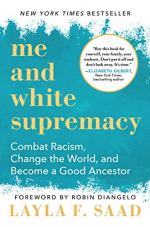|
This section contains 477 words (approx. 2 pages at 400 words per page) |

|
Me and White Supremacy Summary & Study Guide Description
Me and White Supremacy Summary & Study Guide includes comprehensive information and analysis to help you understand the book. This study guide contains the following sections:
This detailed literature summary also contains Topics for Discussion on Me and White Supremacy by Saad, Layla F. .
The following version of this book was used to create this study guide: Saad, Layla F. Me and White Supremacy. Naperville, IL: Sourcebooks, 2020.
Me and White Supremacy is structured as a 28-day series of exercises designed to help readers come to terms with their own complicity in systems of white supremacy. The book’s intended audience is readers holding white privilege, meaning white and white-passing readers. The book begins with a warning that the work of recognizing white supremacy and white privilege is painful, uncomfortable, and difficult. However, that pain is negligible compared to the pain suffered by Black people, Indigenous people, and People of Color (BIPOC) under the white supremacy that still dominates modern society. The reader should expect no praise and no rewards for this work. Instead, they should pursue the lifelong work of antiracism because it is a moral duty. This book serves as a primer that will allow the reader to effectively engage in that work.
Week 1 of the program focuses on defining and illustrating the basic terms and dynamics that shape modern-day white supremacy. Saad explains dynamics such as white supremacy, white privilege, and white fragility. She also illustrates how these dynamics are widely prevalent and socially ingrained, and they do not simply apply to white extremists. Saad also explores ways in which people with white privilege reflexively try to ignore/dismiss matters of race, as well as stifle conversations about race. Each section applies to one day, and each day ends with self-reflective journaling prompts for the reader.
Week 2 focuses on ways in which white supremacy perpetuates itself, as well as ways in which white supremacy actively harms BIPOC. Saad discusses factors such as cultural appropriation, insufficient media representation, and racist stereotypes. Saad also illustrates some of the ways in which white supremacy is directly harmful to the quality of life of BIPOC. These harmful dynamics not only hinder the ability of BIPOC to succeed and thrive, but they also endanger the very lives of BIPOC. Each sections ends with journaling prompts for the reader.
Week 3 focuses on ways in which white supremacy can corrupt white people’s attempts to engage in antiracist work. Saad discusses dynamics such as white apathy, white centering, white saviorism. These dynamics not only hinder antiracist actions by white people, but they can also cause white people’s attempts at antiracist action to be counterproductive. As with previous sections, each day in this section ends with journaling prompts for the reader.
Week 4 focuses on strategies for approaching the lifelong work of antiracism. Saad encourages the reader to actively engage in race-related dialogues with friends, family members and acquaintances. Saad also encourages the reader to approach social issues intersectionally, meaning not to the exclusion of related social issues. Lastly, Saad provides some strategies for how to remain committed to antiracist work in the long term.
Read more from the Study Guide
|
This section contains 477 words (approx. 2 pages at 400 words per page) |

|



